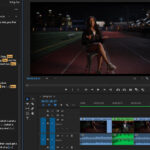Getting a grip on graphics

Posted on Oct 12, 2023 by FEED Staff
Some of the most innovative broadcast tech out there sits within the live graphics sector. The question is, how do you find the savviest on-air solution in an increasingly saturated market?
Broadcast graphics in 2D or 3D are ubiquitous and have specific workflow requirements such as database connections, statistics, tickers, social media or lower-thirds – a variety of elements that are alien to the game engine framework, but essential for broadcast operation. These graphics are often generated out of data from external sources, and are normally pieces of a larger project in which different graphics interact, coming in and out and replacing each other or co-existing depending on the playout requirements.
So, it is not just a question of designing a single graphic, but creating a whole project including many graphics, adding external data and interaction logic on top of the project. Not to mention the graphics may be stand-alone, AR objects on top of real images, or part of a virtual environment.
Broadcast engines have been doing it for decades, evolving to optimise the creation process while facilitating on-air operation. Although many of the above features can be achieved in Unreal Engine by extensively using blueprints, the reality is this process is painfully time-consuming and requires an expert operator.
On-air operation needs to be fast, straightforward and flexible; not just error-proof, but allowing for last-minute edits to be done instantly and easily.
Does this mean we can’t use Unreal Engine for producing dynamic on-air graphics? Not necessarily! But we must be conscious of the game engine’s limitations.
If we need to create blueprints for everything, this may interfere with live operation. Production operators are not familiar with Unreal Engine, and there are always situations in which last-minute changes or unexpected edits are required. Not even the latest Unreal Engine graphics-orientated developments are fully suitable for this workflow, and this is where broadcast engines excel!
Why not have the best of both worlds? Brainstorm’s InfinitySet can effortlessly integrate Aston graphics within the Unreal Engine scene, allowing for advanced audio-visual aids such as in-context typography, motion graphics, statistics, charts and many more examples. These are all perfectly integrated in the composition – in terms of animation, tracking, perspective matching and, of course, image quality.
By employing its Unreal Control module, InfinitySet can manage Unreal Engine’s blueprints, objects and parameters in real time, or even effortlessly create a custom control interface, resulting in a unique and revolutionary workflow that does not require previous preparation of blueprints for every action in Unreal Engine. Unreal Control works in both directions, so it can also transfer any input, including complete Aston graphics with StormLogic.











